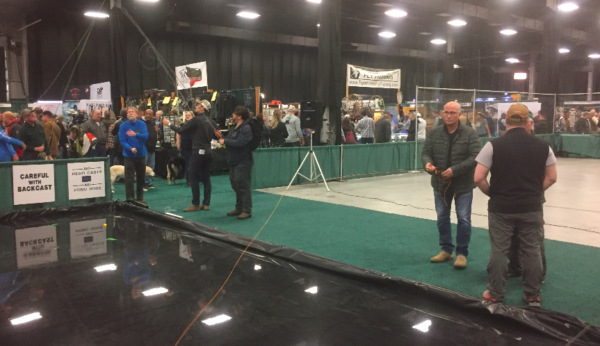It’s been a lengthy debate – pun intended
Comments and musings by Skip Clement on John Frazier’s article Fly Fishing: Short vs. Long Fly Rods for Salt Water Sportsman / November 5, 2014
[dropcap]T[/dropcap]he discussion Frazier points to is that a newbie has to think outside the box – that there is more to selecting saltwater fly fishing rods than an 8- or 9-weight, a reel with 250 yards of backing and a floating line, the preponderance of fly rod, backing and fly line purchases throughout the industry.

Fly fishing shows and fly shops are the best places to find and test drive fly rods. Photo: Derr
Fair enough
But a newbie couldn’t go there – too much information and in a parlance not understood. But that’s not the point of the story. So, first up is go to the local fly shop or show. Buying a new fly rod is like buying a new car. You need to test drive them. But in the case of buying a fly rod, the newbie most likely has never driven one so, having never seen one up close and personal or seen many, he or she has no reference point. Although a BMW and a Lada Riva (Russian) are vastly different cars they are not so to the newly interested buyer.
The performance of a fly rod and intended use are things the author says to consider when buying a fly rod
Timing Matters:
Because a shorter rod is essentially a shorter lever, your stroke should speed up, whereas a longer rod (longer lever) requires a more delayed stroke. The castability of a rod has a lot to do with the relationship between the rod length and the taper of the fly line. A fly line with a short head loads a short rod efficiently and allows the angler to quickly deliver big flies short to moderate distances. The opposite obviously works for longer rods. Rods exceeding the 9-foot mark benefit from fly lines with longer heads.” — Steve Rajeff, Loomis
Mend your Ways:
Even though the technique of mending line — adjusting the position of the line relative to the fly after the line is on the water — is most often associated with river fishing, the tactic has a place in the salt as well, whenever there is current flowing. In salt water, mending comes in handy when fishing rip lines or other current differentials.
Longer rods take a bit more finesse to cast, but with them, you have the potential to cast farther, which is why a lot of deepwater waders and surf guys like them. For this group of anglers, long rods not only offer a little more reach, but they also provide a little more elevation, which goes a long way in terms of preventing line slap on the backcast and avoiding steep banks behind you.” — Steve Rajeff, Loomis
Short and Sweet:
When using heavier lines with short heads, anglers can not only effectively fish in tight quarters but also accurately and quickly present bulky flies short to midrange distances — which is why a lot of guys go with a short rod when stripers and bluefish are feeding on large menhaden.” — Steve Rajeff, Loomis
Frazier concludes that when matched with an appropriate line, short rods achieve considerable distances, but they also provide an edge during the fight — especially with a big, structure-oriented fish.
Read the complete story here . . .
NOTE: John Frazier, former editor at SWS and Fly Fishing in Salt Waters and a nationally recognized authority on saltwater fly-fishing, currently serves as the community specialist for Simms Fishing Products.


